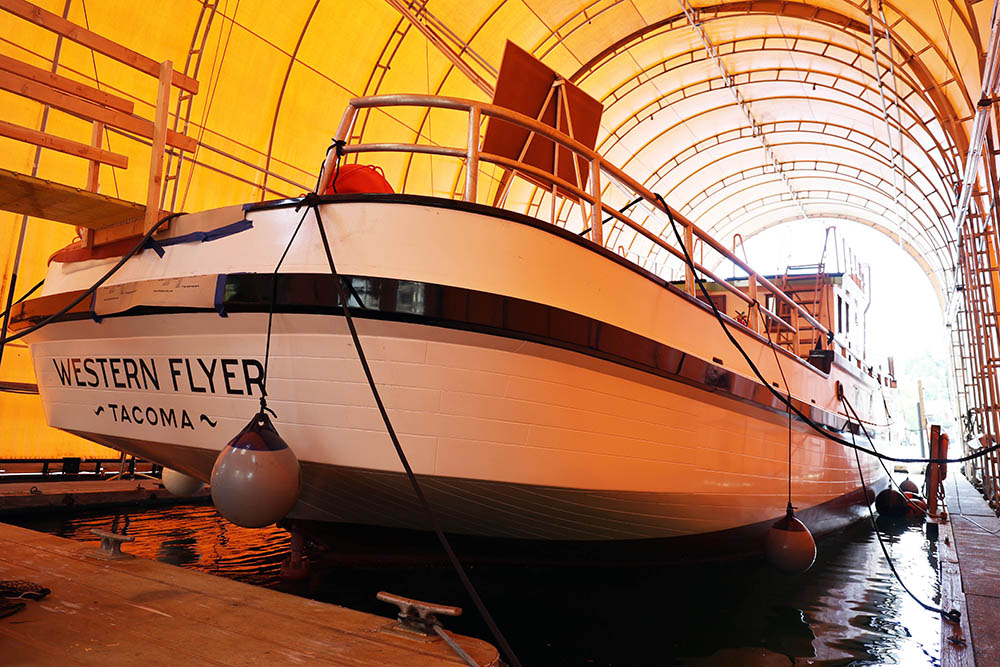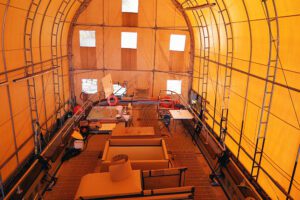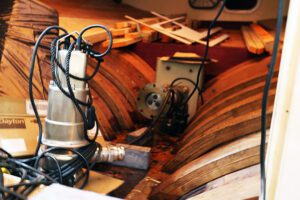
The Tacoma-built purse seiner of Steinbeck fame prepares for a new working life.
The Western Flyer was in dire straits when it was found by John Gregg on the Swinomish Channel in 2015.
The 1937-era wood purse seiner had endured two sinking episodes from 2012 to 2013 and appeared no different than the many doomed derelict workboats of the world. Yet Gregg, inspired, eagerly bought the Western Flyer for around $1 million.
The reason? The Western Flyer is the same purse seiner John Steinbeck and his colleague and marine biologist Ed Ricketts chartered to the Gulf of Mexico in 1940. The expedition to collect and catalogue tidal marine animals is the subject Steinbeck’s Nobel Prize-winning book, The Log from the Sea of Cortez.
Out of the Grave & Back to Work
Gregg, who’s based in the greater Los Angeles area, is a marine geologist and the founder and president of Gregg Drilling & Testing Inc. He has worked in the geotechnical field for over 30 years.
“We basically do distinct foundation analysis for critical buildings like schools and hospitals,” he said, adding that the company takes on projects near-shore and in blue water. “We’re doing foundation design for these new wind turbines and offshore structures.”
Gregg grew up in rural Georgia.
“At that time in the ‘60s, Jackie Kennedy had this program where if a town didn’t have a library, they’d send these bookmobiles,” he recalled, adding that during one of his summer visits to the bookmobile he saw the cover of a book featuring a blue and green colored boat in a stormy sea. It was The Log from the Sea of Cortez.
“That kind of started me on my science path and that was my gateway drug into all Steinbeck reading,” he explained.
The Western Flyer was built by Croatian immigrant Martin Petrich Senior, owner of the Western Boat Company of Tacoma, as a top-of-the-line purse seiner bound to work the booming sardine fishery off Monterey, Calif. when launched in 1937. The vessel was laid as a fir keel with white oak ribs and co-owned between Petrich Senior and fellow Croatian immigrant fisherman Frank Berry.

Frank Berry’s son, Tony Berry, skippered the Western Flyer during the sardine years until the fishery collapsed in the 1946-47 season. The boat was later sold to Armstrong Fisheries of Ketchikan, Alaska.
Tony Berry would be immortalized in The Log from the Sea of Cortez as an exemplary master. “We talked to Tony, the master and part owner of the Western Flyer, and our satisfaction with him as master increased constantly … he took no chances he could avoid, for his boat and his life and ours were no light things for him to tamper with,” Gregg said, quoting Steinbeck.
He kept an eye out for the Western Flyer throughout the years until the fateful 2015 discovery. The famed steed of Steinbeck and Ricketts was on her last legs under the name Gemini. After Gregg bought the boat, the restoration project started the same year.
“These guys at the Port Townsend Shipwrights Cooperative really put their knowledge and skill and effort into this,” Gregg remarked. “They knew this was the project of a lifetime. They didn’t want to mail it in. They didn’t want to make another fishboat. They wanted to make a piano.”
So the Western Flyer Foundation was formed and the vessel was added to the National Register of Historic Places. The restoration was completed and culminated in a launch and rechristening from Gemini back to Western Flyer on June 29, 2022.
“None of it [his Western Flyer plan] makes sense, so it didn’t matter that it was overbudget because it was always overbudget,” explained Gregg. “I was never locked into some belief that we were going to get out of there in two years with $2 million or something like that. I knew it would have its own path and I’d just need to be there to help it on its way.”
Where’s the Western Flyer Now?
At the time of this writing, the Western Flyer has been restored and is floating at the Snow & Company boatyard docks in the Ballard neighborhood in Seattle, where she is getting completely outfitted with modern systems.
“When I was in high school, I built my first boat,” Brett Snow, president of Snow & Company recalled. “That’s what I wanted to do. Surprisingly, I’m still doing it.”
Snow went to boatbuilding school in Port Townsend north of Seattle, and then moved to Denmark where he lived for five years on wooden boats doing carpentry, amongst other things. He settled in Seattle after a transatlantic crossing aboard his motortrawler, the Vesterhavet, and started working on commercial fishing boats, mostly as a carpenter.
Snow started welding aluminum parts for commercial boats around 2000 and built his first seine skiff a few years afterward.
“The growth was fairly slow in the beginning as I was a journeyman carpenter, then slowly got into boatbuilding and gained more and more trust among our clients and hired more and more people,” he said.
Flash forward to today and Snow & Company has built around 110 boats and has contracts across commercial and governmental spaces. S&C outgrew its original facility and expanded to its current location in April, 2020. They do it all: aluminum and steel boatbuilding, repair, conversions, and outfitting.
“I think that’s what attracted the (Western Flyer) group to Snow & Company – our ability to outfit vessels and our experience with repair and conversions on commercial boats as well,” Snow said. “The Port Townsend Shipwrights Co-op did an extraordinary job on the woodwork. Absolutely beautiful work.”
“The Western Flyer is a wolf in sheep’s clothing where the boat is technically very modern,” Gregg remarked. “It’ll have state-of-the-art everything in it, but it looks like an old fish boat.”
Gregg and the Western Flyer Foundation plan to install hi-tech systems and scientific equipment to make the boat fit to conduct research with the best in the industry. The boat will also serve as an educational platform.

“When they came to me, they explained that they were thinking of a hybrid system with this boat, I was thinking great, what a great boat to do it with,” Snow explained. “The shape of the vessel is great to move through the water extremely efficiently, which I’m sure is a concern when designing anything that’s going to be running on batteries.”
The new engine is a John Deere 425-horsepower V6 turbocharged diesel engine, but a Transfluid Industrial Marine unit arriving from Italy will allow Western Flyer operators to freely switch between diesel fuel and electric batteries.
“It [the Transfluid unit] is basically a box about the size of a washer and dryer. It’s like an electric motor that hooks on where the transmission would normally be,” Gregg explained. “The transmission comes right off the engine and into that so it can use the diesel engine as its primary force, or switch to an electric motor. A clutch disengages and then an electric motor turns the drive shaft.”
“Behind that box everything is the same,” he continued. “And if you added enough batteries, you could run completely off the electric motor.”
The long timeline of the Western Flyer did provide one benefit.
“One good thing about taking so long is that we really have seen an evolution in battery technology to the point where I don’t want to invest a lot in money in batteries because they are changing so quick,” Gregg said. The original battery budget, around $1 million, is down to $100,000 for similar performance.
“We’ll have enough to run four, five or six hours without turning the engine on, which is enough to do what we’re trying to do,” he said. “Get it to kelp paddies and other places where we want to be quiet in the water and not disturb anything we’re looking at in the water.”
The Western Flyer’s original engine was a 160-horsepower Atlas, a fantastical contraption from the days of yore.
“It was one of those engines that had those little valves on top and a guy had to be there with an oil can,” Gregg remarked. The original Atlas engine weighed 20,000 pounds compared to the new engine’s 3,000 pounds.
The Log from the Sea of Cortez even mentions the Western Flyer’s original engine.
“Her engine was a thing of joy, spotlessly clean, the moving surfaces shining and damp with oil and the green paint fresh and new on the housings,” one passage states. “The engine-room floor was clean and all tools polished and hung in their places. One look into the engine-room inspired confidence in the master. We had seen other engines in the fishing fleet and this perfection on the Western Flyer was by no means a general thing.”
“That (160 horsepower) is a small engine to move a 77-foot boat at the 10-knot hull speed. But the boat has a slippery hull design, so it had that classic wineglass profile. It is quick in the water,” Gregg said.
Efficient and seaworthy hulls were the name of the game in old school – some would call timeless – boatbuilding. The tow from Port Townsend provided Gregg some insight into the Western Flyer’s hull form bona fides.
“When we were towing the boat from Port Townsend with the tugboat the other day, the tugboat and the Flyer cumulatively only took 330 horsepower. It really is slippery in the water,” he said proudly.
What’s Next
“All along the goal wasn’t to create a museum piece. Ricketts and Steinbeck were always forward-thinking guys,” Gregg stated. “They wouldn’t have liked a boat that couldn’t earn its keep.”
The Western Flyer Foundation’s stated vision is to inspire deeper appreciation of marine environments, see the world through the lenses of both science and art and understand the place of communities in a larger world.
“We’re going to do real research with NOAA and the U.S. Navy, and we’ll take long-term readings on the coast for the next 10 or 20years, which haven’t really been done before,” Gregg remarked.
“I think one of the goals of the Western Flyer Association and one of the goals of my company is hopefully to inspire young people to follow things that they’re interested in,” Snow said. “Would I love it if a bunch of kids came through the shop and became boatbuilders? Absolutely. But what would be more important to me is if a bunch of kids came to the shop and decided that they could do anything and went after it with a passion.”
While Gregg didn’t want to announce a precise Seattle departure date, he teased a nature-inspired timeframe.
“We’re thinking the leaves will either be really red or there won’t be any leaves at all, but no green buds. No cherry blossoms. Maybe a straggling leaf or two,” he commented.
Gregg said he anticipates a few stops before arriving at Moss Landing Marine Labs in Northern California for the loading of the new scientific equipment aboard.
“And then,” he said, “we’ll start the programs in the spring.”
